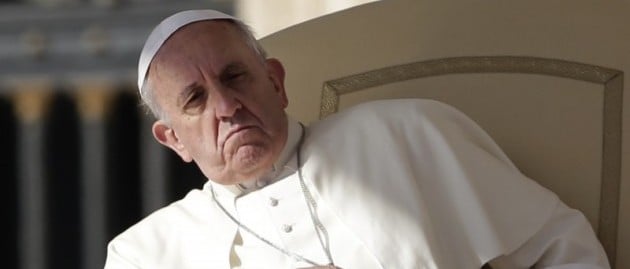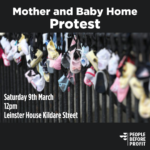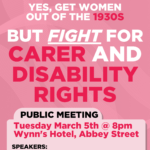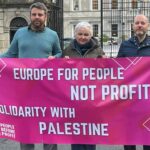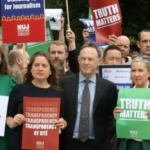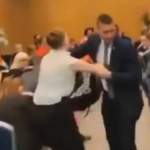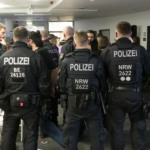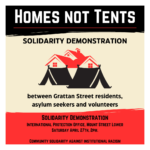Pope Francis will soon be visiting Ireland. For many people Francis is a progressive figure, even an Anti-Capitalist. But how do such claims square with the actual practice of the Pope, both past and present? Historian Brian Kelly examines this question for Rebel.
In the five years since he became Pope, Francis—known before coming to Rome as Jorge Mario Bergoglio—has, through a series of highly symbolic gestures, raised the hopes of millions around the world who look around in vain for some sliver of humanity in a world marked by deep inequality and intensifying polarization. His first official visit was to the Italian island of Lampedusa, an arrival point for tens of thousands of refugees from north Africa, whose shores have been the final resting place for hundreds who did not survive the perilous journey. There he spoke from an altar constructed out of boat wrecks, calling for a “reawakening of consciousness” in a world that has “forgotten how to cry”. Three years later, against a backdrop of rising xenophobia, he spent Holy Thursday at an asylum centre outside of Rome, washing the feet of refugees, “our brothers and sisters in search of a better life, far away from the poverty, hunger, exploitation and the unjust distribution of the planet’s resources which are meant to be shared equitably by all.” Last month he added his voice to those outraged by the separation of children from their parents in Trump’s border pens, denouncing the policy as “immoral”.
Powerful gestures like these have raised expectations that Francis will set about a root-and-branch transformation of the Catholic Church, wielding its influence on behalf of the oppressed around the world. But the same acts have outraged conservatives in and outside the Church. “We can’t wait for him to die,” an English priest told the Guardian, a sentiment echoed by a Polish Archbishop censured recently after openly calling for Francis’s assassination. His views on divorce and homosexuality, another senior cleric insists, had allowed the “smoke of Satan” into the Vatican. Cardinal Raymond Burke—“one of the most conspicuous reactionaries in the Vatican” and mentor to prominent right-wing American Catholics Newt Gingrich, Pat Buchanan, Bill O’Reilly and Steve Bannon—has orchestrated a growing campaign to have Francis tried for ‘heresy’ for his (ambiguous) position on gay rights and his urging that divorced and cohabiting Catholics should be allowed to take communion. American shock-jock Rush Limbaugh objects loudly to the “pure Marxism” in Francis’s critique of ‘unfettered capitalism’.
How should the Left understand these unfolding tensions, and what should our attitude be toward those who look to Francis as a voice of human solidarity in perilous times? Can the Catholic Church be a force for change, or is it beyond redemption, intrinsically wedded to the existing order? Is Francis an ally in the struggle against growing inequality? To answer these questions it is necessary to trace the causes of the crisis facing the Catholic Church and to situate the evolution of the present Pope’s ‘anti-capitalism’ in the profound convulsions that have rocked the Latin American church. This can clarify for both progressive lay Catholics and the non-religious Left what precisely is at stake in the internal war now underway in the Church hierarchy.
A Church in Crisis
The decline in the moral authority of the Catholic Church in Ireland has been especially steep, but is symptomatic of a wider crisis that the Vatican now confronts internationally. Much of this is self-inflicted. In the south of Ireland, where the Church hierarchy were virtual partners in wielding state power alongside a deeply conservative middle class, revelations about the scale of the barbarism carried out in the name of Catholic morality have permanently diminished its standing. The large majorities voting for marriage equality and repeal of the 8th Amendment confirm the deep shift that has occurred here. In the north the Church has never recovered from the steep decline brought on, in part, by its siding with a repressive state throughout the Troubles. Elsewhere across the globe the particular constellation of circumstances vary from one country to the next, but the trends reveal the same problem: a Church wedded to archaic ritual and a deeply conservative political vision, completely out of step with its diminishing flock.
The conservative posture of the Catholic Church over recent decades is consistent with its record over centuries. For most of its long history the Church was an integral element of the ruling order, and even after direct power slipped from its grasp with the end of feudalism the hierarchy angled to stay close to the new ruling classes being thrown up by capitalism. In pre-independence Ireland the Church served as a kind of ‘loyal opposition’ in a vastly unequal social order overseen by London; more than a century ago James Connolly denounced them for “ever preaching humility yet sitting in the seats of the mighty.” But even by those standards the strident conservatism of the past generation stands out, embodied in the tenure of two of the most reactionary figures in recent Church history: the Polish Bishop Karol Wojtyła, later Pope John Paul II; and Joseph Ratzinger, who after a contentious tenure as Wojtyla’s heresy hunter was made Pope Benedict XVI.
Their elevation was part of an attempt by reactionary elements at the top of the Church hierarchy to roll back the tepid liberalism of Vatican II—which had discarded some of the more antiquated church ritual (the Latin mass, for example) and aimed to “open the windows and let in some fresh air” by directing clerics to go out and re-engage with the world around them. The deep resentment these changes generated among traditionalists festered away until they found traction in the crisis brought on by the social upheavals of the late 1960s. Wojtyla had been nursed on the virulent anti-communism of the Polish church—strident in denouncing oppression in the Soviet sphere, he had difficulty mustering outrage about inequality in the west; Ratzinger had begun as a moderate but abruptly changed course in the face of the 1968 radicalization in Germany; their elevation to the papacy was pushed forward by a network of influential conservatives enjoying immense power in Rome and beyond.
In religious terms the Catholic Right clung tightly to tradition and high ritual, dismissing the suggestion that worship should be made more accessible to lay Catholics. Politically they were aligned with the global Right, and in the 1980s would play an important role in prosecuting counterrevolution in Latin America. Everywhere they reacted sharply against the powerful challenge posed by an ascendant women’s movement—rejecting demands for reform both within the wider society (opposing divorce and contraception) and inside the Church itself. Ratzinger, in particular, would carry this into the Vatican—rejecting not only the possibility of ordaining women as priests but even the suggestion that they might “sing in choirs or serve at the altar”. All of these instincts were on clear display during the sexual abuse scandals that rocked the Church in the US: the Boston Globe rightly pointed out that John Paul—with Ratzinger in a prominent supporting role—was “guilty of one of the biggest institutional cover-ups of criminal activity in history.”
Bergoglio, Liberation Theology and Argentina’s ‘Dirty War’
Bergoglio came up through the ranks of an Argentinian church dominated by reactionaries who shared this deep conservatism, and in his early career seemed comfortable in that milieu. Across much of Latin America, the hierarchy identified its interests with those of the ruling elites, and in the context of the Cold War came to identify defense of the Church with support for right-wing, fanatically anti-communist regimes across the region, including those ruled by military dictatorships. Rome not only did not object, but seemed to eagerly endorse this approach.
The hierarchy’s role in defending the harsh and unequal social order that dominated the lives of the most oppressed among lay Catholics led inexorably toward an open rupture in the Latin American Church. A powerful “Catholic Left” had been developing in civil society in Brazil and elsewhere in the 1950s and 60s. Parallel tensions were developing inside the structures of the Church, becoming more pronounced after Vatican II. Often the fracture lines reflected divisions between the conservative hierarchy and those clergy whose work brought them into daily contact with workers and the poor, though the lines were never so neatly drawn. Left-wing ideas were strongest among the nearly 160,000 clergy in the religious orders—Jesuits, Franciscans, Maryknolls, Dominicans—a majority of whom were actually women, many of whom were Europeans or North Americans shocked by the depths of misery they encountered in Latin America, and whose rigorous intellectual training had brought them into contact with Marxism.
In the mid-1970s these tensions burst into the open with the publication of a manifesto for “liberation theology” published by the Peruvian theologian Gustavo Gutierrez. He insisted that the Church must show a “preferential option for the poor” and commit itself to overthrowing the structural inequalities fundamental to capitalism. His counterpart in Brazil, Leonardo Boff, participated in a movement comprising a hundred thousand ‘base communities’ in which lived 4 million poor and working class Brazilians. In a context of rapid industrialization and mass migration to cities like São Paulo, these would play a critical role in galvanizing a wave of strikes that would challenge the military government and lay the groundwork for the early formation of the Workers’ Party (PT).
Some sense of the profound radicalization that had taken hold can be found in the early documents of the movement. In his influential writings Gutierrez insisted that “only a radical destruction of the present state of things, a profound transformation of the ownership system, the coming to power of the exploited class, a social revolution will put an end to [oppression].” The main resolution passed at a continental gathering of the Christians for Socialism movement in 1972 proclaimed:
Faith intensifies the demand that the class struggle move decisively towards the liberation of all men [sic]—in particular, those who suffer the most acute forms of oppression…. The real context for a living faith today is the history of oppression and of the struggle for liberation from this oppression. To situate oneself within this context…one must truly participate in the process of liberation by joining parties and organizations that are authentic instruments of the struggle of the working class.
Three points are worth emphasizing about the rise of liberation theology. First, while at one level the “preferential option for the poor” was compatible with a long tradition of Catholic Social Teaching (indeed Ratzinger would later try to reclaim the phrase for the conservative Church), what distinguished the Catholic Left was the shift from charity to self-emancipation: for liberation theologists, the poor were “agents of their own liberation and the subjects of their own history.” Secondly, its emphasis on the need for revolutionary transformation placed the Catholic Left out in front of both the sclerotic Communist Parties in the region—which hankered after a ‘progressive bourgeoisie’ that would develop Latin America—and many of the guerrilla organizations that sought cross-class alliances against US imperialism. The final, more problematic point is that, as Michael Löwy has noted, everywhere liberationist Christianity tread carefully on questions around “sexual ethics, divorce, contraception and abortion—in short, women’s free disposition over their bodies.” While they developed principled approaches to the oppression of indigenous peoples and the descendants of African slaves in the region, only a handful of liberationists called for decriminalizing abortion. Here, Löwy writes, the ‘progressive’ Church “still defend[ed] traditionalist and backward positions [not] shared by all lay Catholics.”
This important exception aside, there is no question that by the mid-1970s conservatives had lost their grip over Latin American Catholicism. The diminution of their authority coincided with a wave of wider insurgency and revolt across the region. Panic took hold in the Vatican, where the Left’s ascent was viewed as a serious threat; alongside the most right-wing elements in the regional hierarchy, Rome embarked on a systematic campaign aimed at extinguishing the ‘heresy’ of class struggle. This would lead them into a tacit alliance with the death squads unleashed by US imperialism, greatly intensifying after the overthrow of the US-backed Somoza dictatorship in Nicaragua in 1979.
John Paul II’s finger-wagging at the left-wing priest (and Sandinista Minister of Culture) Ernesto Cardenal at a time when US-run militias (known as the contras) were embarked on a bloody counterrevolution captures the dynamic. In the US the Reagan administration explicitly targeted liberation theology, “passing money to a large number of sympathetic bishops and priests” and “supply[ing] information about hundreds of radical priests and nuns, who then became victims of the military dictatorships”. They poured arms into the region and encouraged the penetration of the region by US-based right-wing evangelicals to counter the radicals’ influence. In military terms, a sustained counter-offensive led to the deaths of thousands of liberationist clergy and hundreds of thousands of civilians across the region: more than 75,000 in El Salvador, an estimated 250,000 in Guatemala, 40,000 in Nicaragua, 30,000 in Argentina.
Bergoglio’s Argentina occupied a unique position throughout this period: in 1976 the military seized control with the full consent of senior clergy. One historian describes the Argentine hierarchy as “the black sheep of Latin America in the passive way they dealt with the military dictatorship”; an ex-General recalled with relief that the Argentine Church never became “carried away by the leftist Third World tendencies [elsewhere on] the continent.” The Argentine hierarchy—with openly fascist elements at the top—were complicit in horrific brutality. They staffed regime torture centres with Catholic ‘chaplains’ whose actual function was to gather intelligence for the military; they oversaw a system under which infants born to pregnant women undergoing torture would be “taken from their mothers immediately” and handed over to “families sympathetic to the regime.” They absolved the regime for its policy of tossing political prisoners (including nuns) out of helicopters into the Atlantic Ocean: “[military] chaplains told the men performing the killings that their actions were justified by the Gospel parable of separating the wheat from the chaff”.
Though he was not part of the hard-Right element in the upper levels of the Argentine hierarchy, Bergoglio’s role during Argentina’s ‘Dirty War’ remains a subject of intense controversy. In the face of shift to the left within the Church, he distinguished himself as a conservative hostile to liberation theology. It was largely down to Bergoglio’s leadership, for example, that while across the region Jesuits were prominent on the left, in Argentina the order “did not march in unison” with developments elsewhere. His most sympathetic biographers concede that Bergoglio “kept his mouth shut” throughout the period the regime was carrying out its worst atrocities, but there are indications that his actions bordered on complicity. The ‘social institute’ he directed in Buenos Aires was silent on torture at a time when 20,000 victims were known to have been ‘disappeared’ by the regime. In the most serious controversy, critics charge that Bergoglio “gave a green light” for the regime to arrest two Jesuit priests who had defied his directive to withdraw from working in the slums: they were abducted and subjected to severe torture. He was so despised among rank-and-file Jesuits that the order banished him to Córdoba for two years exile.
Francis’s ‘Anti-Capitalism’ and Its Limits
Although in the absence of hard evidence nothing definitive can be said about the
role Bergoglio played in the Dirty War, in a sense this is beside the point. His main role had been as an ideological opponent of liberation theology, and in this he marched consistently in step with Rome. In the face of a forceful challenge from the Left, Bergoglio played an important role in articulating a new ‘middle ground’ between church traditionalists and the liberationists. This is evident in his interventions in the 1980s, but begins to take more definite form from the early 1990s onwards—years marked by liberation theology’s decline, when its opponents throughout the Church began to endorse some of the language of the movement, and even some of its forms (‘base communities’) while “emptying [them] of their class-based political vision”. This is critical: the precondition for Bergoglio’s assuming the role of a critic of “unbridled capitalism” was the success of Rome’s counter-offensive against liberation theology.
Bergoglio had long advocated a theology of class reconciliation, of “persuad[ing] the rich to surrender power rather than help the poor to take control of their own destiny.” Again, this was not out of sync with the Church’s teaching over a long period: John Paul himself had suggested that “the development of a more harmonious society is going to require both forgiveness from the poor, for past exploitation, and sacrifice from the rich,” and Benedict had frequently emphasized the same point in combatting liberation theology. But Francis’s articulation of this well-worn perspective stood out more conspicuously in a neoliberal world, where public discourse was everywhere saturated by the worship of market forces. One skeptic rightly pointed out that in his calls for solidarity between rich and poor and the amelioration of capitalism’s “excesses” Bergoglio had “moved from the right to the middle not the left.”
His attachment to a kind of theological ‘third way’ intensified after 2001, when Argentina’s economy went into a tailspin after defaulting on $94b in debt. Half the population was pushed below the poverty line and one in four thrown out of employment. Police killed dozens of protestors in the upheaval that followed and the country went through five governments over a period of two weeks. These early clashes were followed by long and brutal years of IMF-imposed austerity, and in this context Bergoglio began to articulate a “theology of the people” that adapted the language of a waning liberation theology in advocating amelioration of the excesses of “unfettered capitalism”. This critique—developed in the particular context of the Argentine crisis—took on new, global relevance after the 2008 crash, and the message that Francis now regularly articulates in railing against global inequality is rooted in the perspective he adopted then.
Between Gesture and Action
Stripped of its religious covering, Francis’s perspective is rooted in a fairly straightforward reformism that would not look out of place in the program of any mainstream social democratic party in the 1960s or 1970s. Though there are inconsistencies and ambiguities on display, at root it is a call for a return to a social harmony that is alleged to have marked capitalism in the heyday of the welfare state. In place of the social ownership of the means of production central to the vision of liberation theologists, Francis wants the rich to care more about the poor and oppressed.
At times Francis leavens this plea for reform with forceful, moving, and (it would seem) genuine expressions of solidarity with the poor and oppressed. But even here the record is marked by limitations and ambiguities, a striking gap between gesture and action. This is most apparent in his refusal to make a clean break with the despicable treatment of victims of Church sexual abuse by his predecessors, but it is evident also in his contradictory position on women (washing their feet but reaffirming the Church’s ban on ordination), on gay marriage, and on abortion rights. The Catholic Right is outraged that Francis has moved away from their unwavering obsession with issues around sexuality and reproductive freedom—an obsession deliberately promoted by the Vatican to marginalize the anti-capitalist critique of the liberation theologists—but beyond the change in emphasis Francis has reaffirmed his clear opposition to marriage equality, and to any retreat from the Church’s opposition to abortion. Some of his remarks attempt, disgracefully, to make link the ‘throwaway culture’ of modern capitalism with abortion rights—implying that women who choose to terminate a pregnancy do so on a whim, or out of the same selfishness that drives social inequality. Mary McAleese’s comment that the Church under Francis remains “one of the last great bastions of misogyny” are on the mark, and exposes some of the most glaring and untouched contradictions in modern Catholicism.
Marxists share the hopes of many religious believers from all backgrounds for a world cleansed of inequality and oppression, a world in which humanity—in tune with the finite resources of the planet we share—can exercise control over its destiny and build a society marked by solidarity rather than competition, division and endless war. We reject the notion that women and men must put off that aspiration until the afterlife, and with it the belief that the power to win that world will emanate from some force other than our collective power. While socialists should not be indifferent to the tensions being played out in a Church with more than a billion members worldwide, and while we should add our voices to the calls for human solidarity that Francis and others articulate, the hope for change lies in the power of working people united across national boundaries and organized to seize the future for themselves.

